Apple iPad mini with Retina Display: Reviewed
by Anand Lal Shimpi on November 16, 2013 8:00 AM ESTThe SoC
The iPad mini with Retina Display rounds out the three platforms that use Apple’s A7 SoC. Although both the iPad Air and iPhone 5S use the A7, the mini’s implementation is closer in nature to the iPhone. The iPad mini’s SoC has always used the same package-on-package (PoP) assembly as the iPhone, with DRAM stacked on top of the SoC itself (1GB in this case). The benefit is obviously a reduction in board area, the downsides have to do with cost and thermals. That’s the first similarity between the mini’s A7 and the iPhone’s A7.
The second is one of frequencies. While the iPad Air’s A7 runs its two Cyclone CPU cores at up to 1.4GHz, the SoC in the iPad mini and the iPhone 5S runs at up to 1.3GHz. That might sound like a minor difference, but it’s far more pronounced when you look at what happens to frequency when you’re running heavy workloads.
Once again I turn to a fairly heavy CPU workload to plot performance over time. This is a multithreaded workload, slightly modified from what we used in the iPad Air review, designed to make the CPU cores consume max power. The scale is linear and the workload is the same across all devices, so what you’re effectively looking at is a graph of thermally bound CPU performance over time across all three A7 implementations:
Being the largest device (and the only device with a metal heat spreader and no DRAM stacked on top), the iPad Air obviously maintains the highest frequencies for the duration of the test. The iPhone 5S, with a significant reduction in internal volume (and a PoP SoC) reduces its CPU frequencies early on in order to keep skin temperature down and properly manage thermals. The iPad mini with Retina Display falls between the two, with its performance curve more closely following that of the iPhone 5S.
Although the mini has a similar max operating frequency to the iPhone 5S, it is a faster device thanks to it being less thermally constrained. Similarly, the iPad Air can be much faster than its clock speed would otherwise imply. If you’re wondering why Apple has been so focused on building its own SoCs and CPU architectures, this is the reason why. There’s a fixed amount of power you can dissipate in the form of heat in these mobile devices while still maintaining a good user experience. Performance per watt is the gating metric for success in mobile, and shipping high IPC/low frequency dual-core SoCs at 32/28nm is the best optimization available to a company like Apple today.
As you’d expect, our browser based CPU tests show the mini’s A7 performing in between the iPhone 5S and iPad Air. None of these tests are anywhere near as stressful as our thermal test from above, so we don’t see exaggerated differences in performance between the platforms. For most, I suspect you won’t notice a huge performance difference between the mini and Air. Those who are heavier users (e.g. audio mixing, 3D gaming, etc…), there will be a performance difference between the two iPads.
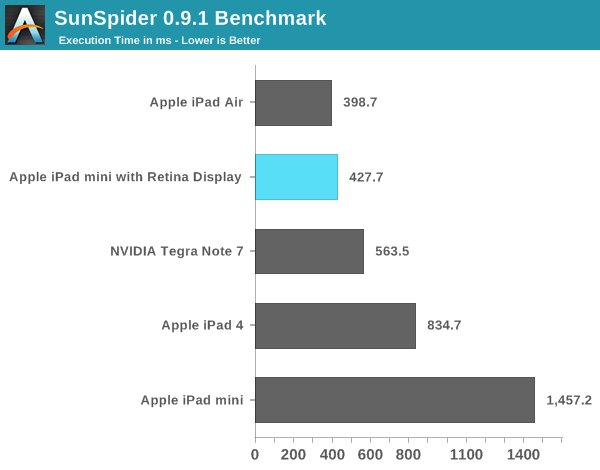
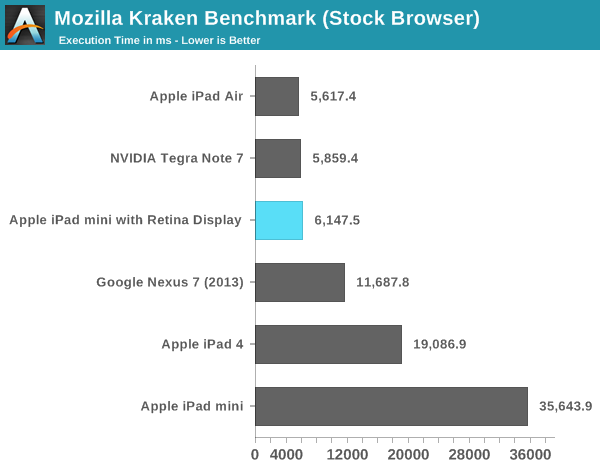
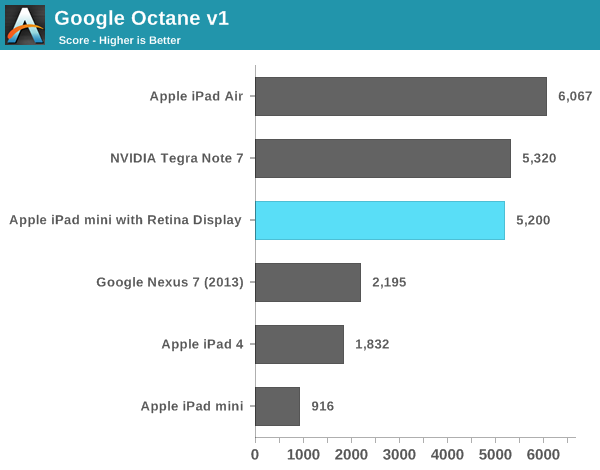
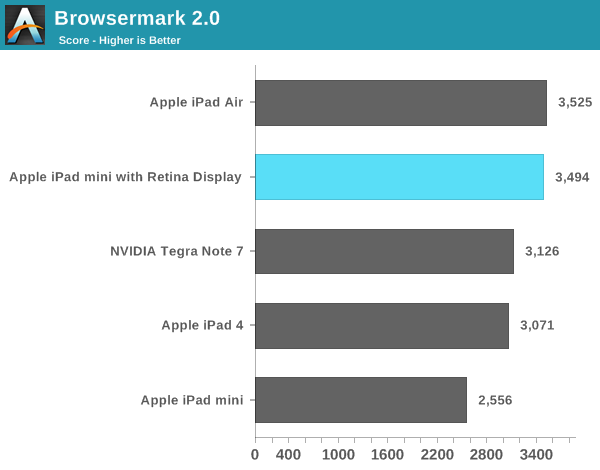
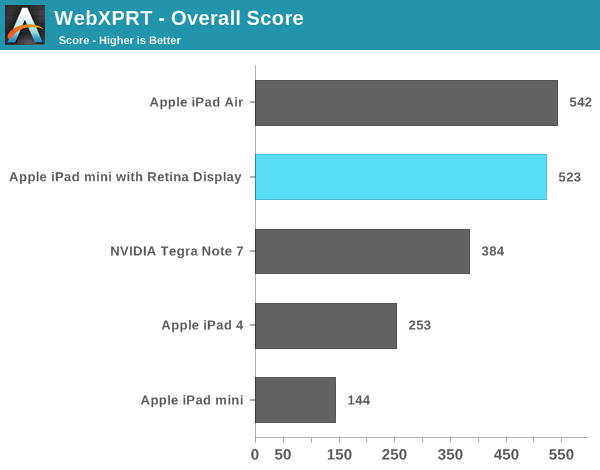
Compared to the first generation iPad mini, the new model is in a completely different performance league. Keep in mind the first mini used Apple’s A5 SoC based on an ARM Cortex A9. That’s the same single threaded performance as what’s in an iPhone 4S, and under iOS 7 it’s clearly running into some performance limits. The new mini with Retina Display however is a completely different animal. It’s fast.
Even comparing to the 4th generation iPad, the new mini is noticeably quicker.
Memory Bandwidth
Looking at the iPad mini’s memory bandwidth curve, we see it tracks very closely with that of the iPhone 5S. This is a slightly modified version of our previous bandwidth test, and you can see peak usable memory bandwidth (from the CPU’s perspective) of around 10GB/s. The ~12GB/s area right before you get out to main memory is bandwidth to the A7’s 4MB system-wide cache that sits after the shared L2 and the memory controller. This cache appears to service CPU, GPU and ISP requests at least.
GPU Performance
I believe the A7’s PowerVR G6430 GPU runs at around 450MHz. This frequency appears unchanged across all three A7 implementations. Once again, the big difference is how much thermal headroom exists in the platform which has an impact on overall performance.
Kishonti’s low level GPU performance tests back up my assertion that GPU frequency is fixed across all A7s. The iPad mini with Retina Display delivers equal performance to the iPad Air. The bigger news here is that nearly all of the GPU bound 3D tests seems to peg the mini and Air as equals. These are some pretty intense tests, but it looks like on the GPU side there’s no significant throttling when running at full tilt.
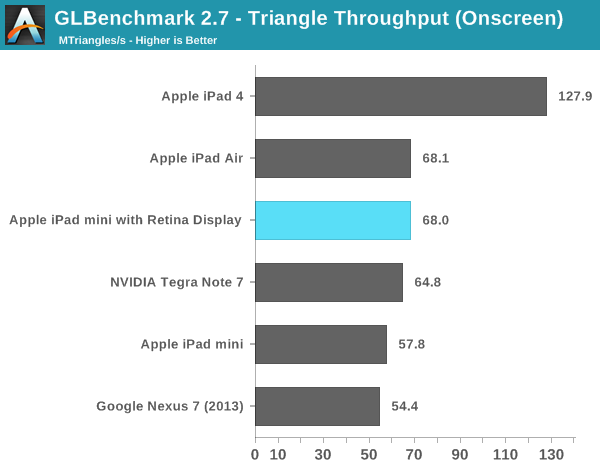
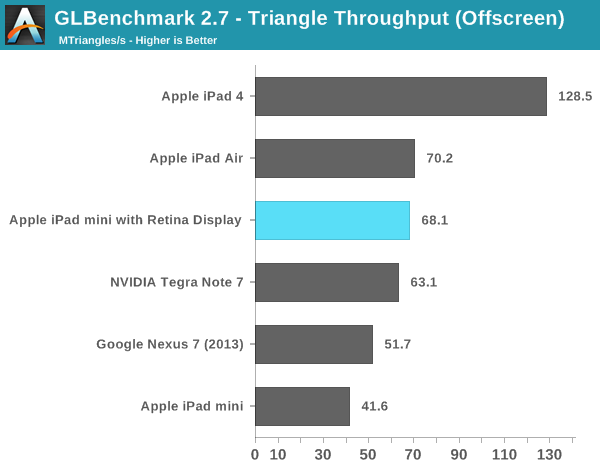
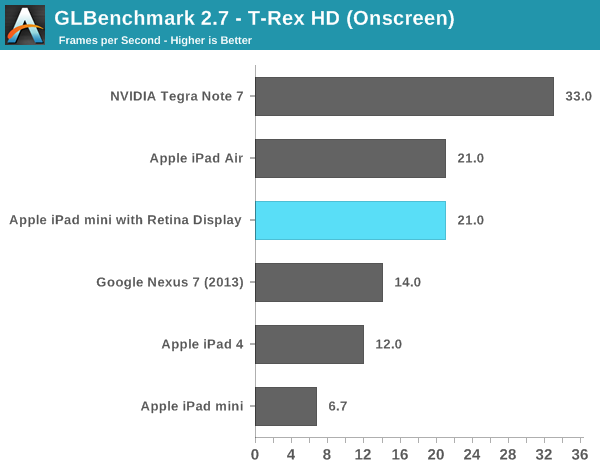
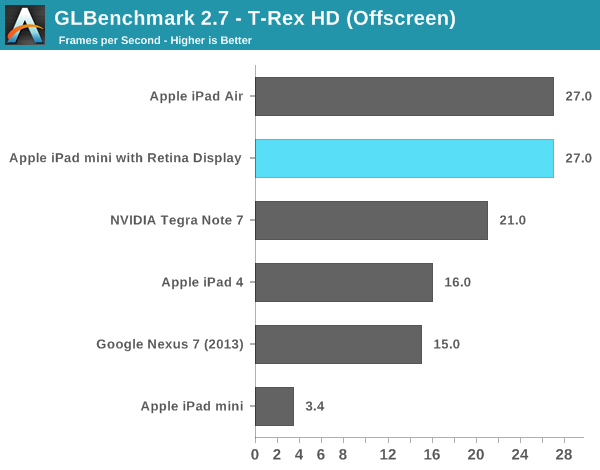
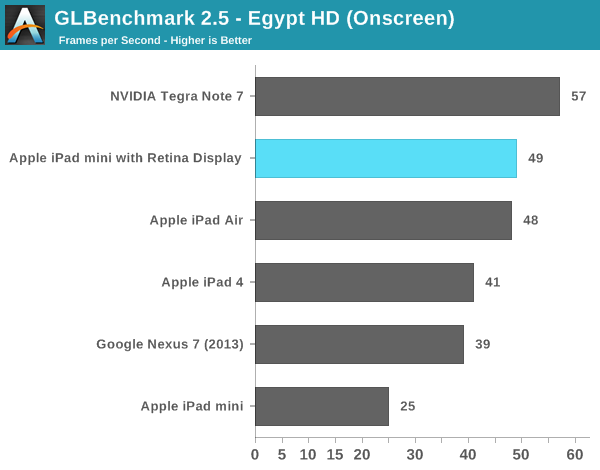
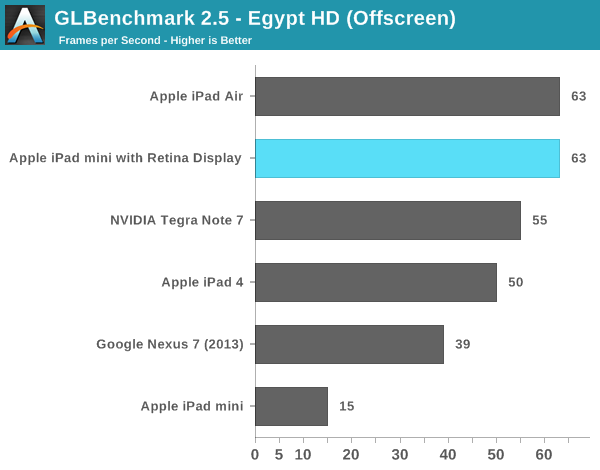
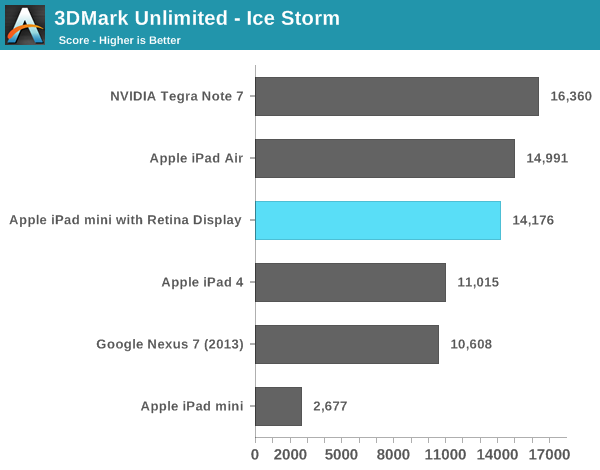
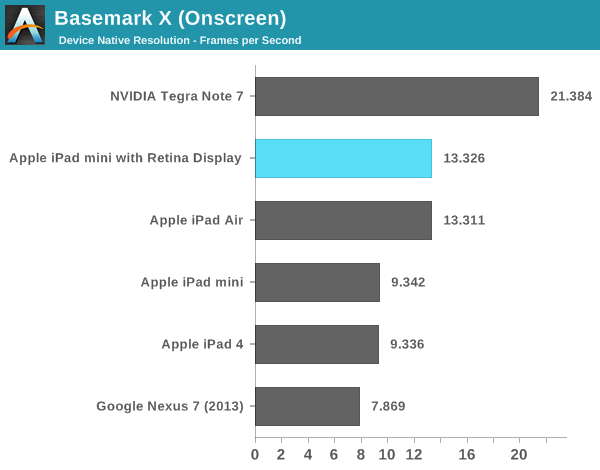
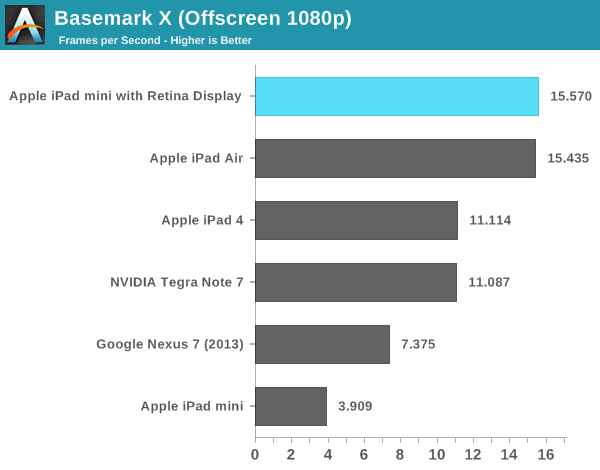
As I mentioned in our iPad Air review, despite having less peak theoretical memory bandwidth than the A5X/A6X, the A7 in the iPad mini never seems to regress in performance compared to even the iPad 4. Across the board the mini appears to be faster, more responsive and have more performance on tap than any prior iPad (big or small). The comparison to the original iPad mini is of course night and day. Even looking at lighter tests like the old GLBench Egypt HD benchmark, the iPad mini with Retina Display manages to be nearly twice as fast as the original mini - all while rendering 4x the number of pixels.


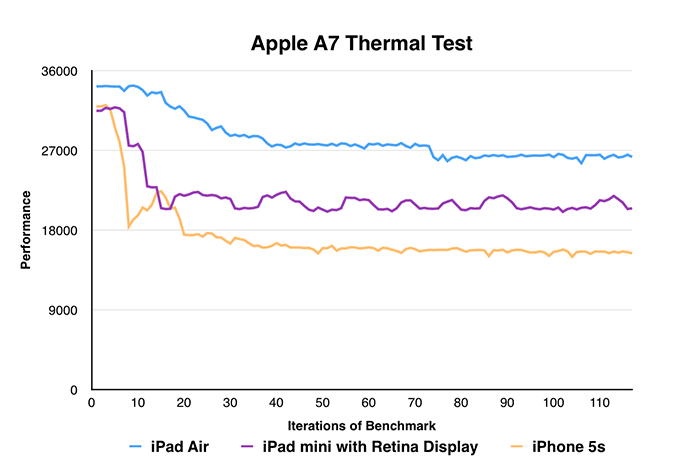
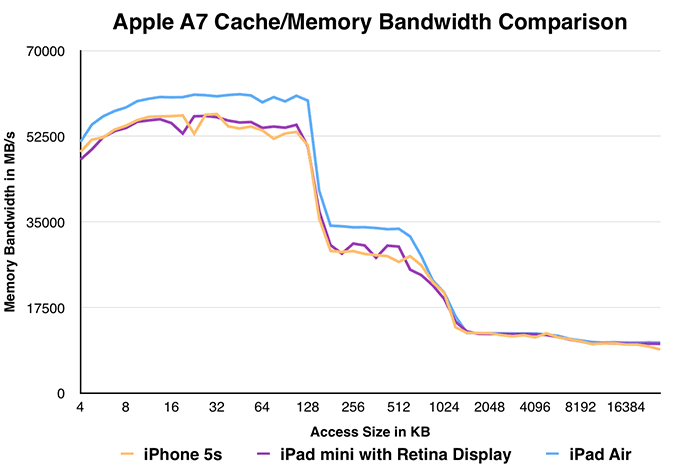








345 Comments
View All Comments
BPB - Saturday, November 16, 2013 - link
Came here just to see if the Apple love would be 10 out of 10, or 11 out of 10. Not surprised it's an 11.Jaaap - Saturday, November 16, 2013 - link
There are also al lot of verifiable facts in the article.BearT - Saturday, November 16, 2013 - link
Liked the article: 1. The display of iPad mini w/ Retina is superb, and its size dwarfs that of others in this category (e.g. Nexus 7). This matters to me as I read magazines in portrait mode. 2. I tried the browsers from a number of devices. The "Reader" feature of Safari is a must, if you loathe online ads as much as I do. 3. The high fidelity of the FaceTime "audio" is uncanny; one has to try it to appreciate the "pin-drop" sound across the globe, okay, just the long-distance. The normal phone audio doesn't come close in clarity!eggcustard - Sunday, November 17, 2013 - link
I use Readability on my N7.RannXeroxx - Sunday, November 24, 2013 - link
Looks like an interesting app, going to try it out. Thanks.julandorid - Sunday, November 17, 2013 - link
Actually, the final rating is pretty accurate! The review mention all of the important flaws as the quality of the display which is still decent but not quite as good as it is on the Nexus 7. Also a very important thing is the price. The author of this review is not convinced that (double) price is justified anyhow. Actually the contrary. He practically encourage the buyers to take the Nexus 7 in serious consideration.My personal opinion is the display is not that bad as it is described, but it is entirely a conscious decision made by Apple to calibrate the display with much lower brightens in order to achieve a good battery and correct gamma. If they decided to put an extra power to the led backlight and does a different calibration then I guess we would have a better screen but in the expense of pretty bad battery life. Apple did a smart move by offering great performance and good battery life. Probably no body will notice the display since it is already better (I mean sharper) that it was previously. That gives Apple another chance, next year to advertize an even better iPad mini.
The only serious concern that I have is the price! It is a known fact for years that Apple never rise the price (because it is already too high anyway) and always keep it the same while refreshing the product's internal and external components with better ones. However this year they decided to do the opposite - to increase the price even further.
So, for me was no-brainer to go with the new Nexus 7. Great device, great display. I always smile when I look at it.
Mahadragon - Sunday, November 17, 2013 - link
True, Apple generally keeps the price of devices like the iPhone and iPad the same. The iPhone 5S is the same price as the iPhone 5, however, you fail to take into consideration that the iPhone 5S has the same screen as the iPhone 5. The 5S has a finger print sensor and uses the A7 processor, those were the upgrades.The iPad Mini (original) made 2 steps up in processing power going from the A5 to the A7 processor and made a massive leap in resolution going to the retina screen. The Mini Retina also requires a much larger battery than the previous Mini to power all that nice hi-resolution screen which actually forced Apple to make an iPad Mini that is thicker and slightly heavier than the previous generation.
In short, the upgrade path from the original Mini to the Mini Retina was not a standard upgrade. It was a massive upgrade which prompted a much larger price increase.
winkgood - Monday, November 18, 2013 - link
Sounds like you are just making excuses for Apple. When they went from the ipad 2 (non-retina) to ipad 3 (retina), they kept the same price even though the new device has a better soc and higher resolution. (2 steps up)I believe they kept the same price point when they went from the iphone 3gs to 4 and from the 4s to 5, both of which involved improved screens and better guts. (2 steps up)
They got greedy and wanted to keep their insanely high margins.
ws3 - Monday, November 18, 2013 - link
Apple's margins are not insanely high, as proven by the fact that for most of their products, they sell everything they make. How long has the iPhone 5s been out now and most Apple stores still can't keep them in stock.ELPCU - Monday, November 18, 2013 - link
There is no doubt that Apple's margin are insanely high. Especially in phone area, they are making a tons of margin per phone. I do not know how can u say this stupid argument. Don't you see how expensive every fucking Apple accessory is? Don't you see how much apple makes u pay for increase tiny bit of storage? Go check isuppli, and look up their bill of material.I need to admit iPad, especially iPad mini series with 16GB wifi's margin is not too high, but margin from iphone per every fucking phone is just ridiculus. Why? because your phone cost is very deceptive, since 2/3~ish price is hidden under contract. You feels you are just paying 200 bucks per phone(for lowest storage), but apple takes bunch of money from AT&T or T-mobile, etc. You are actually paying 650 bucks(unlocked phone price). Most of iphone series have approximately SAMEish bill of material. around 200 bucks including manufactuing cost, and margin rates of higher storage one gets increased even more.
Bill of material is not exact number used for calculating margin, because of warranty cost, marketing cost, licensing cost, etc, but if you uses 150% of BOM, which will give very close number of real unit price.
Which means apple is making more than 100% margin rate in phone market.
You think more than 100% of margin rate is not insanely high? you must be kidding me.